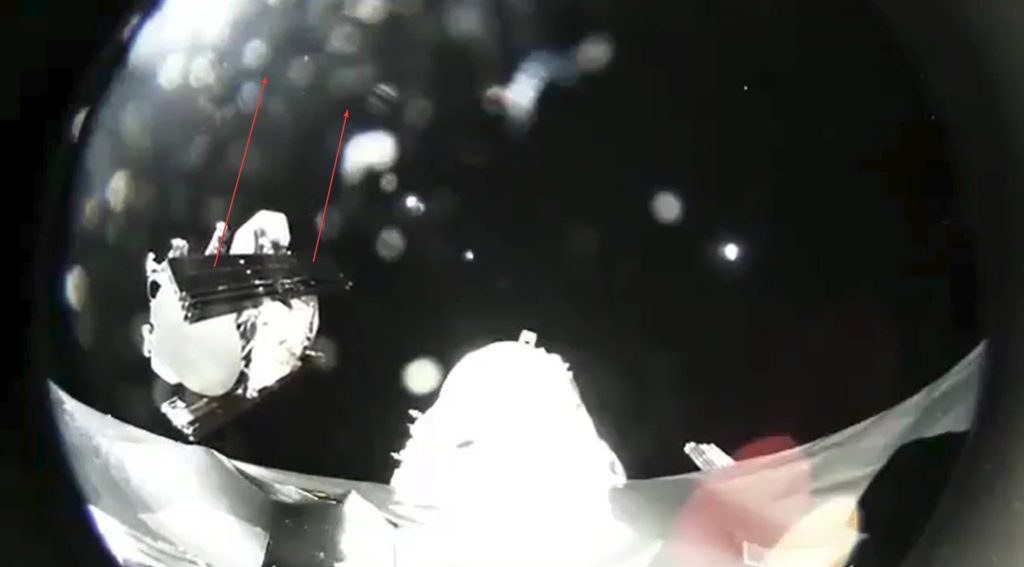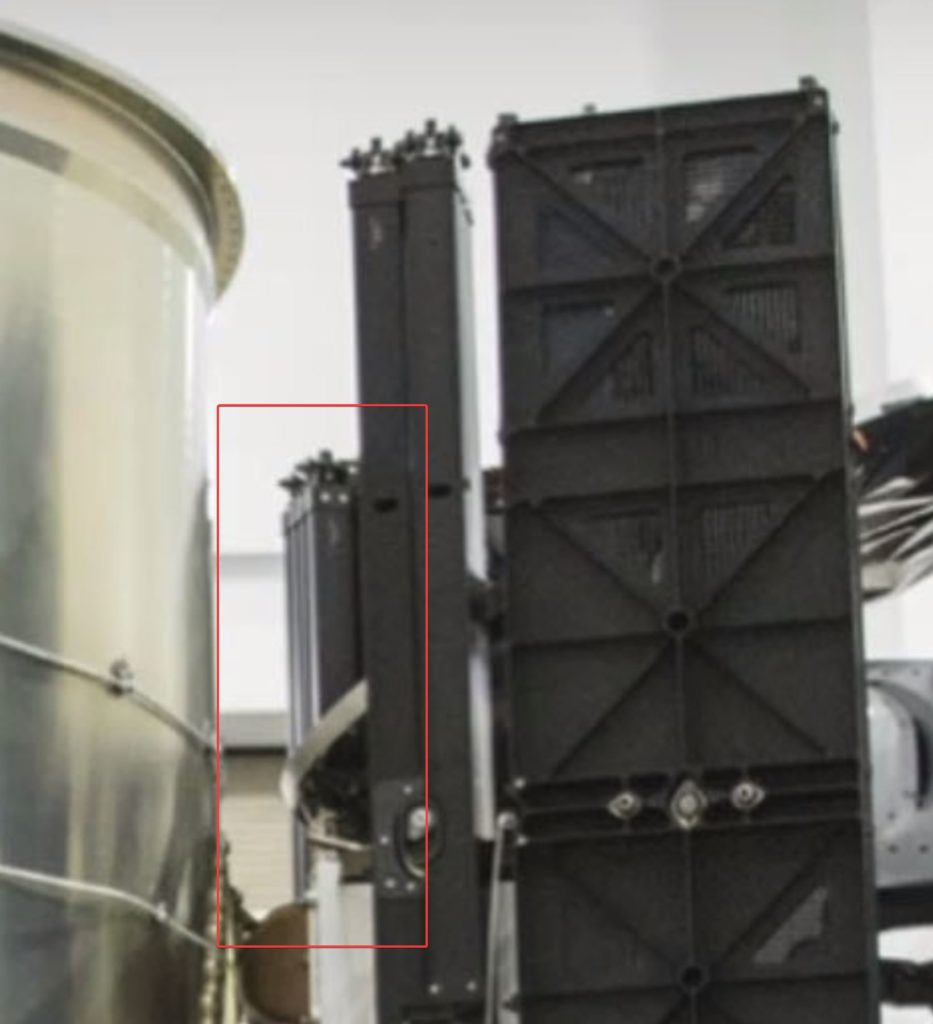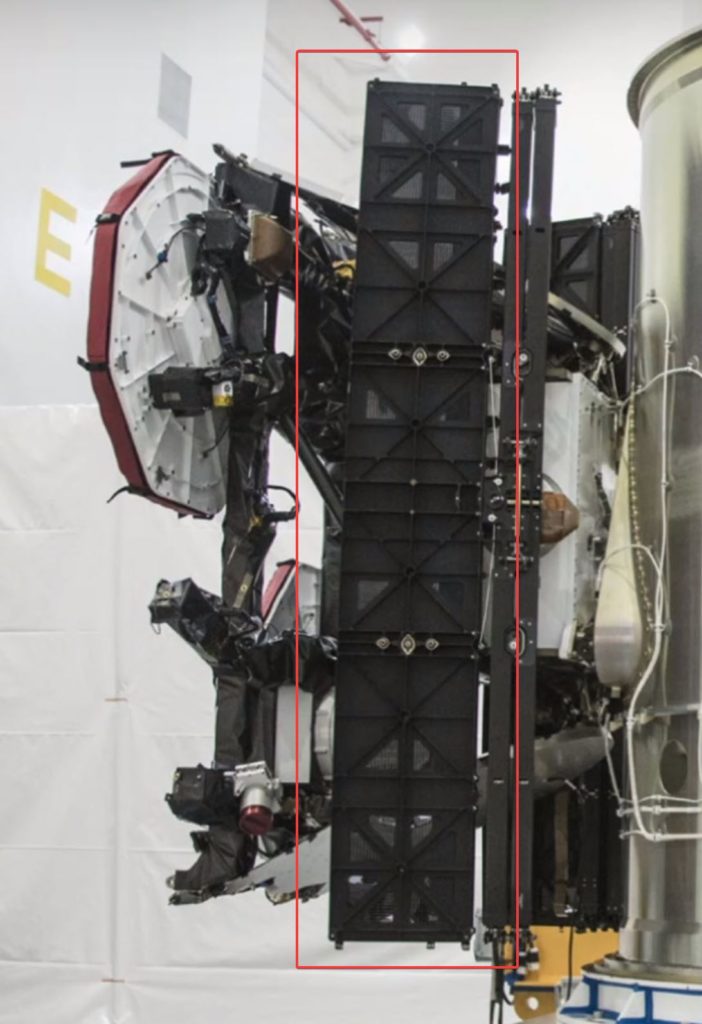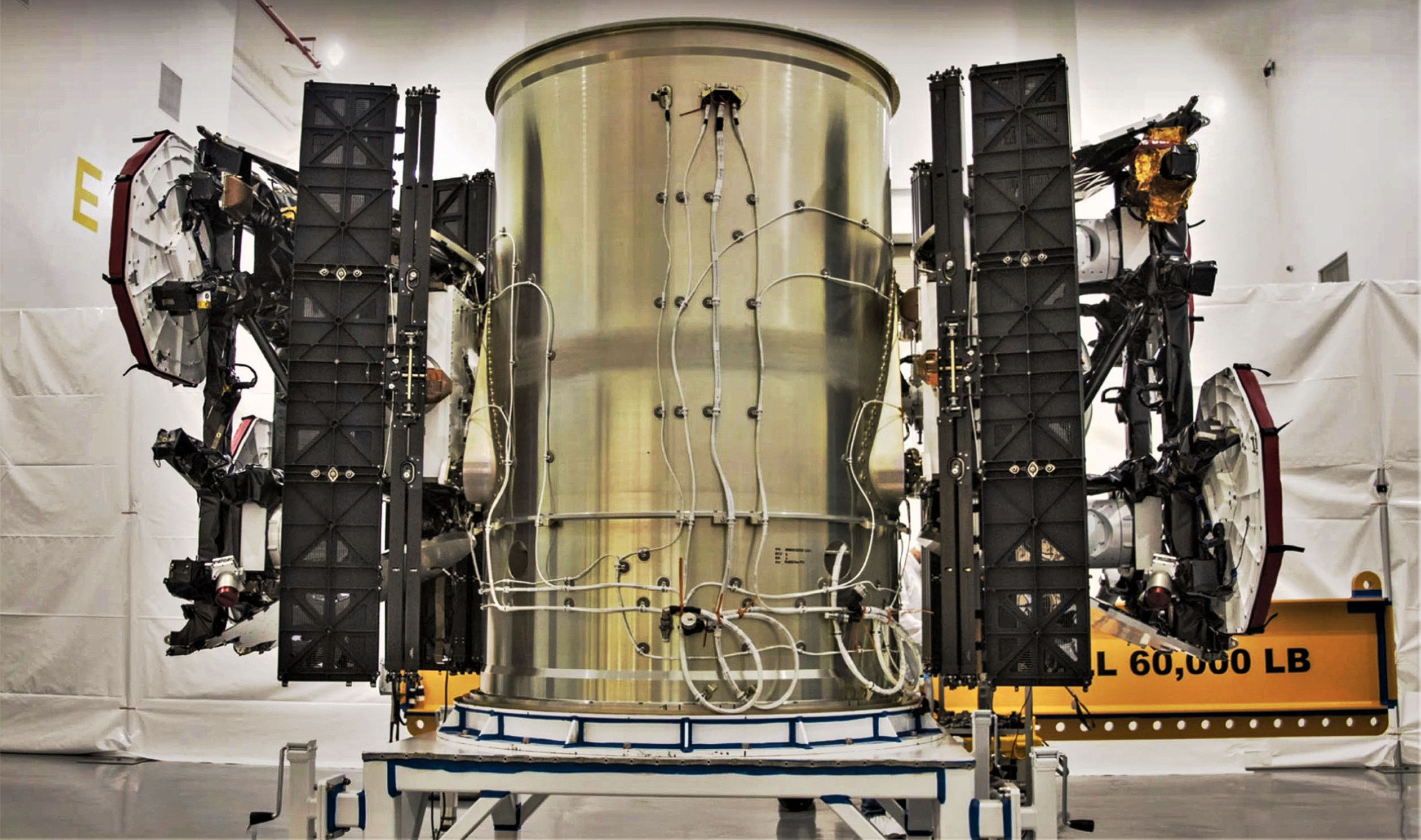
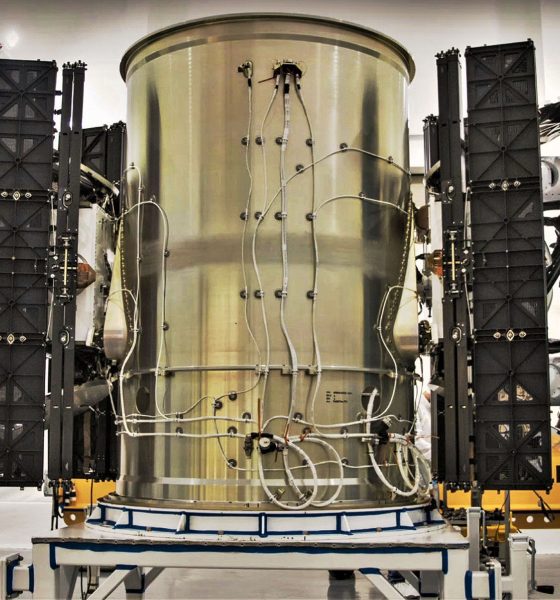
SpaceX
SpaceX’s Starlink satellites may use unique solar array deployment mechanism
Spotted on an official SpaceX T-shirt commemorating Starlink’s first two prototype satellites and corroborated through analysis of limited public photos of the spacecraft, SpaceX appears to be testing a relatively unique style of solar arrays on the first two satellites launched into orbit, known as Tintin A (Alice) and B (Bob).
It’s difficult to judge anything concrete from the nature of what may be immature prototypes, but SpaceX’s decision to take a major step away from its own style of solar expertise – Cargo Dragon’s traditional rigid panel arrays – is almost certainly motivated by a need to push beyond the current state of the art of satellite design and production.
- The axis Tintin solar arrays would deploy along. (SpaceX)
- Just like a scissor mechanism, Tintin’s solar arrays have an extremely thin sandwich of what looks like four interlocking leaves. (SpaceX)
- If the thin structure is a scissor deployment mechanism, the wider black section would be a housing for wiring and the solar array panels, likely thin and flexible rectangles that fold out to reach their full 6m length. (SpaceX)
Unlike any discernible solar panel deployment mechanism with a flight history, SpaceX’s Starlink engineers seem to have taken a style of deployment used successfully on the International Space Station and mixed it with a modern style of solar arrays, relying on several flexible panels that can be efficiently packed together and designed to be extremely lightweight. While a major departure from SpaceX’s successful Cargo Dragon solar arrays, the mechanisms visible on the Tintins seem to have the potential to improve upon the packing efficiency, ease of manufacturing, and number of failure modes present on Dragon’s panels.
In essence, those three motivations are indicative of the challenges SpaceX’s Starlink program must solve in a more general sense. In order to even approach SpaceX’s operational aspirations for Starlink (i.e. high-speed internet delivered from space almost anywhere on Earth), the company will need to find ways to mass-produce hundreds or thousands of high-performance satellites annually at a price-per-unit unprecedented in the history of commercial satellites, all while keeping the weight and volume of each satellite as low as possible (no more than a few hundred kilograms).
To give an idea of where the industry currently stands, satellite internet provider Viasat launched its own Viasat-2 spacecraft in 2017. Weighing in around 6500 kg (14300 lb), the immense satellite cost at least $600 million and offers an instantaneous bandwidth of 300 gigabits per second, impressive but also gobsmackingly expensive at $2 million/Gbps. To ever hope to make Starlink a reality, SpaceX will need to beat that value by at least a factor of 5-10, producing Starlink satellites for no more than $1-3 million apiece ($4.5B-$13.5B alone to manufacture the initial 4,425 satellite constellation) with a bandwidth of 20 Gbps – baselined in official statements.
Compared to the state of the art, a $1 million satellite with optical (laser) interlinks, multiple phased array antennae, electric ion propulsion, two 1-2 kW solar arrays, and bandwidth on the order of 20 Gbps is – to put it nicely – wildly ambitious. Fundamentally, SpaceX will need to revolutionize design and mass-production of all of the above subcomponents, and perhaps the unfamiliar solar arrays present on the Tintin twins are a first step towards tackling at least one of those revolutions-in-waiting.
Will do another rev before final design
— Elon Musk (@elonmusk) May 27, 2018
According to CEO Elon Musk, another set of prototype satellites will likely be launched and tested in orbit before settling on a finalized Starlink design.
For prompt updates, on-the-ground perspectives, and unique glimpses of SpaceX’s rocket recovery fleet check out our brand new LaunchPad and LandingZone newsletters!

News
SpaceX shades airline for seeking contract with Amazon’s Starlink rival

SpaceX employees, including its CEO Elon Musk, shaded American Airlines on social media this past weekend due to the company’s reported talks with Amazon’s Starlink rival, Leo.
Starlink has been adopted by several airlines, including United Airlines, Qatar Airways, Hawaiian Airlines, WestJet, Air France, airBaltic, and others. It has gained notoriety as an extremely solid, dependable, and reliable option for airline travel, as traditional options frequently cause users to lose connection to the internet.
Many airlines have made the switch, while others continue to mull the options available to them. American Airlines is one of them.
A report from Bloomberg indicates the airline is thinking of going with a Starlink rival owned by Amazon, called Leo. It was previously referred to as Project Kuiper.
American CEO Robert Isom said (via Bloomberg):
“While there’s Starlink, there are other low-Earth-orbit satellite opportunities that we can look at. We’re making sure that American is going to have what our customers need.”
Isom also said American has been in touch with Amazon about installing Leo on its aircraft, but he would not reveal the status of any discussions with the company.
The report caught the attention of Michael Nicolls, the Vice President of Starlink Engineering at SpaceX, who said:
“Only fly on airlines with good connectivity… and only one source of good connectivity at the moment…”
CEO Elon Musk replied to Nicolls by stating that American Airlines risks losing “a lot of customers if their connectivity solution fails.”
American Airlines will lose a lot of customers if their connectivity solution fails
— Elon Musk (@elonmusk) December 14, 2025
There are over 8,000 Starlink satellites in orbit currently, offering internet coverage in over 150 countries and territories globally. SpaceX expands its array of satellites nearly every week with launches from California and Florida, aiming to offer internet access to everyone across the globe.
Currently, the company is focusing on expanding into new markets, such as Africa and Asia.
News
Tesla hints at Starlink integration with recent patent
“By employing polymer blends, some examples enable RF transmission from all the modules to satellites and other communication devices both inside and outside the vehicle.”

Tesla hinted at a potential Starlink internet terminal integration within its vehicles in a recent patent, which describes a vehicle roof assembly with integrated radio frequency (RF) transparency.
The patent, which is Pub. No U.S. 2025/0368267 describes a new vehicle roof that is made of RF-transparent polymer materials, allowing and “facilitating clear communication with external devices and satellites.”
Tesla believes that a new vehicle roof design, comprised of different materials than the standard metallic or glass elements used in cars today, would allow the company to integrate modern vehicular technologies, “particularly those requiring radio frequency transmission and reception.
Tesla has recently filed a US patent application on integrating RF transparent materials into the roof structure.
“facilitating clear communication with external devices and satellites”
Tesla fleet is getting @Starlink connectivity integration soon. LFG @Tesla @elonmusk… pic.twitter.com/bLa8YtPLd1
— Chansoo Byeon (@Chansoo) December 9, 2025
Instead of glass or metallic materials, Tesla says vehicles may benefit from high-strength polymer blends, such as Polycarbonate, Acrylonitrile Butadiene Styrene, or Acrylonitrile Styrene Acrylate.
These materials still provide ideal strength metrics for crashworthiness, stiffness for noise, vibration, and harshness control, and are compliant with head impact regulations.
They would also enable better performance with modern technologies, like internet terminals, which need an uninterrupted signal to satellites for maximum reception. Tesla writes in the patent:
“By employing polymer blends, some examples enable RF transmission from all the modules to satellites and other communication devices both inside and outside the vehicle.”

One of the challenges Tesla seems to be aware of with this type of roof design is the fact that it will still have to enable safety and keep that at the forefront of the design. As you can see in the illustration above, Tesla plans to use four layers to increase safety and rigidity, while also combating noise and vibration.
It notes in the patent that disclosed examples still meet the safety requirements outlined in the Federal Motor Vehicle Safety Standards (FMVSS).
Starlink integrated directly into Tesla vehicles would be a considerable advantage for owners. It would come with a handful of distinct advantages.
Initially, the inclusion of Starlink would completely eliminate cellular dead zones, something that is an issue, especially in rural areas. Starlink would provide connectivity in these remote regions and would ensure uninterrupted service during road trips and off-grid adventures.
It could also be a critical addition for Robotaxi, as it is crucial to have solid and reliable connectivity for remote monitoring and fleet management.
Starlink’s growing constellation, thanks to SpaceX’s routine and frequent launch schedule, will provide secure, stable, and reliable internet connectivity for Tesla vehicles.
Although many owners have already mounted Starlink Mini dishes under their glass roofs for a similar experience, it may be integrated directly into Teslas in the coming years, either as an upgrade or a standard feature.
Investor's Corner
SpaceX IPO is coming, CEO Elon Musk confirms
However, it appears Musk is ready for SpaceX to go public, as Ars Technica Senior Space Editor Eric Berger wrote an op-ed that indicated he thought SpaceX would go public soon. Musk replied, basically confirming it.

Elon Musk confirmed through a post on X that a SpaceX initial public offering (IPO) is on the way after hinting at it several times earlier this year.
It also comes one day after Bloomberg reported that SpaceX was aiming for a valuation of $1.5 trillion, adding that it wanted to raise $30 billion.
Musk has been transparent for most of the year that he wanted to try to figure out a way to get Tesla shareholders to invest in SpaceX, giving them access to the stock.
He has also recognized the issues of having a public stock, like litigation exposure, quarterly reporting pressures, and other inconveniences.
However, it appears Musk is ready for SpaceX to go public, as Ars Technica Senior Space Editor Eric Berger wrote an op-ed that indicated he thought SpaceX would go public soon.
Musk replied, basically confirming it:
As usual, Eric is accurate
— Elon Musk (@elonmusk) December 10, 2025
Berger believes the IPO would help support the need for $30 billion or more in capital needed to fund AI integration projects, such as space-based data centers and lunar satellite factories. Musk confirmed recently that SpaceX “will be doing” data centers in orbit.
AI appears to be a “key part” of SpaceX getting to Musk, Berger also wrote. When writing about whether or not Optimus is a viable project and product for the company, he says that none of that matters. Musk thinks it is, and that’s all that matters.
It seems like Musk has certainly mulled something this big for a very long time, and the idea of taking SpaceX public is not just likely; it is necessary for the company to get to Mars.
The details of when SpaceX will finally hit that public status are not known. Many of the reports that came out over the past few days indicate it would happen in 2026, so sooner rather than later.
But there are a lot of things on Musk’s plate early next year, especially with Cybercab production, the potential launch of Unsupervised Full Self-Driving, and the Roadster unveiling, all planned for Q1.
